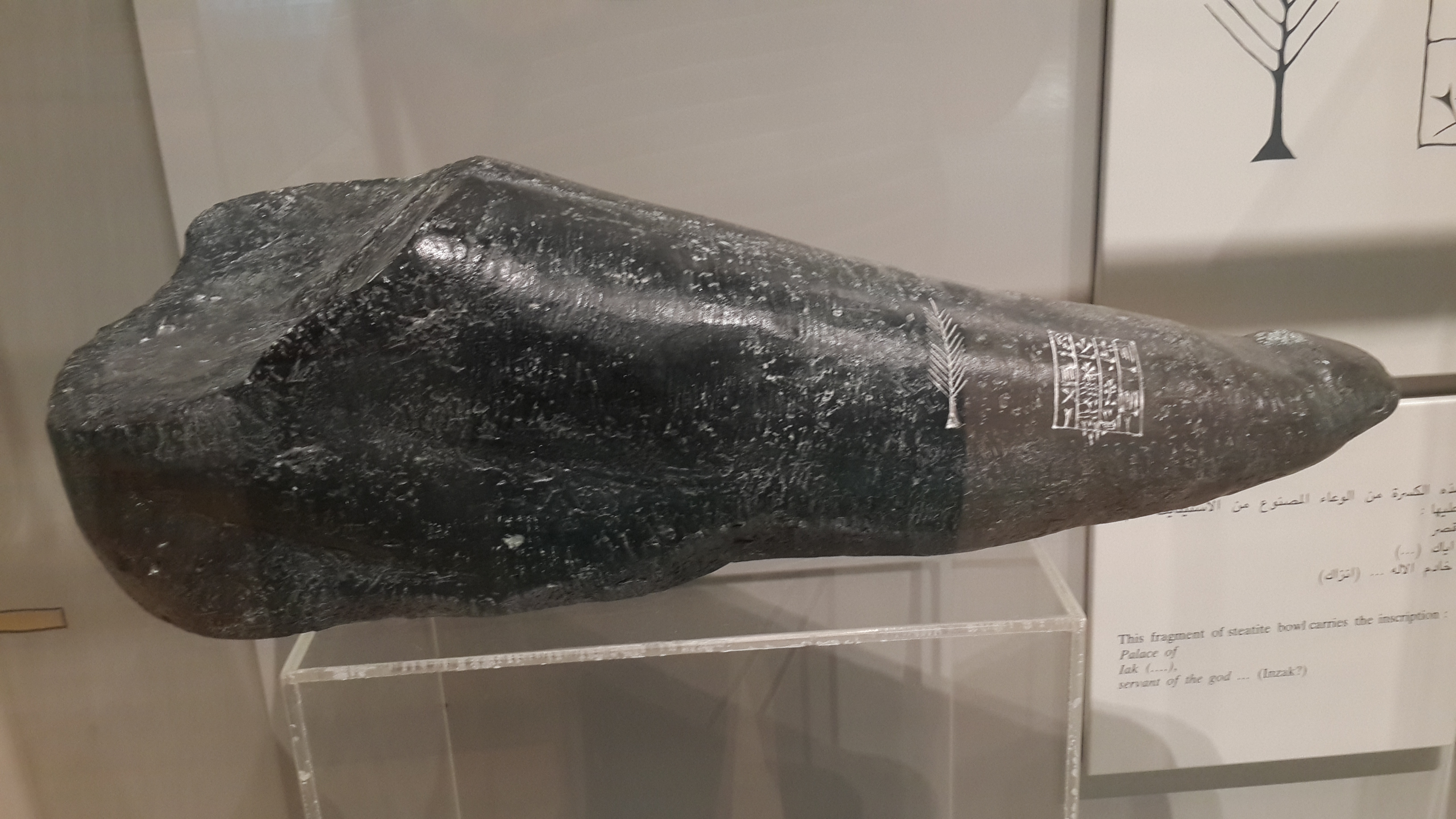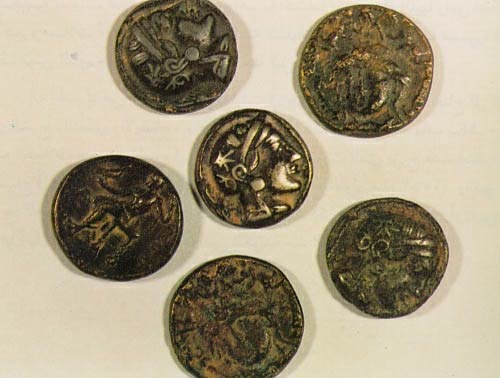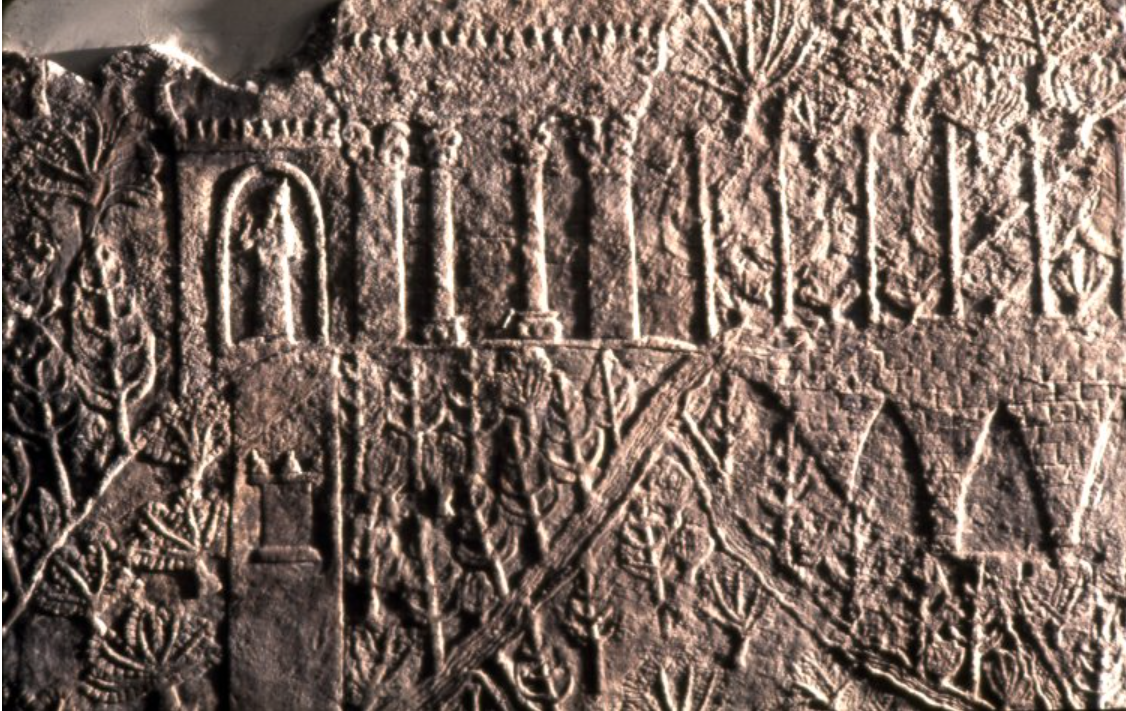|
Inzak
Inzak (also Enzag, Enzak, Anzak; in older publications Enshag) was the main god of the pantheon of Dilmun. The precise origin of his name remains a matter of scholarly debate. He might have been associated with date palms. His cult center was Agarum, and he is invoked as the god of this location in inscriptions of Dilmunite kings. His spouse was the goddess Meskilak. A further deity who might have fulfilled this role was dPA.NI.PA, known from texts from Failaka Island. Evidence of the worship of Inzak is also available from Mesopotamia, where he appears for the first time in an inscription of king Gudea. He is attested in theophoric names from locations such as Ur, Lagaba and the Sealand. Mesopotamians at some point came to perceive him as analogous to the god Nabu. He also appears as an independent deity in the myth Enki and Ninhursag, in which he is referred to as the "lord of Dilmun." A temple dedicated to Inzak also existed in Susa in Elam. He was either worshiped there ... [...More Info...] [...Related Items...] OR: [Wikipedia] [Google] [Baidu] |
Meskilak
Meskilak or Mesikila was one of the two main deities worshiped in Dilmun. The other well attested member of the pantheon of this area was Inzak, commonly assumed to be her spouse. The origin of her name is a subject of scholarly dispute. She is also attested in texts from Mesopotamia, where her name was reinterpreted as Ninsikila. A different deity also named Ninsikila was the spouse of Lisin, and might have started to be viewed as a goddess rather than a god due to the similarity of the names. Under her Mesopotamian name Meskilak appears in the myths ''Enki and Ninhursag'' and ''Enki and the World Order'', in which she is associated with Dilmun. In Dilmun It is assumed Meskilak was one of the two main deities of Dilmun, the second one being Inzak, often interpreted as her spouse by researchers. An alternative proposal is that he was her son. An attested variant of Meskilak's name is Mesikila. The origin of the theonym Meskilak is not certain, and various proposals have been made ... [...More Info...] [...Related Items...] OR: [Wikipedia] [Google] [Baidu] |
Agarum
Agarum (also transliterated as Agaru or Akarum, cuneiform: ''a-kà-rum'' or ''a-ga-rum'') is a bronze-age Near Eastern proper name, probably a toponym for a region or island in the Eastern Arabia and Persian Gulf. Agarum has been generally identified with Kuwait's Failaka Island, known as ´KR to the Arameans and as Ikaros during the Hellenistic times. Failaka's Ekara temple is another probable location.Glassner 1988, pp. 240-243. Agarum is sometimes identified with the mediaeval city of Haǧar, in the general region of Al-Ahsa Oasis in Saudi Arabia and Bahrain Island in Bahrain. The name Agarum is attested in the earlier half of the 2nd millennium BCE, mentioned in inscriptions of the ancient Dilmun civilization (modern-day Bahrain). Agarum was associated with Inzak, the chief deity of Dilmunite pantheon. Several Dilmunite kings styled themselves as "servants of the Inzak of Agarum"; such kings included Rimum (c. 18th century BCE), Yagli-El (c. 18th and 17th centuries BCE), and ... [...More Info...] [...Related Items...] OR: [Wikipedia] [Google] [Baidu] |
Dilmun
Dilmun, or Telmun, ( Sumerian: , later 𒉌𒌇(𒆠), ni.tukki = DILMUNki; ar, دلمون) was an ancient East Semitic-speaking civilization in Eastern Arabia mentioned from the 3rd millennium BC onwards. Based on contextual evidence, it was located in the Persian Gulf, on a trade route between Mesopotamia and the Indus Valley civilisation, close to the sea and to artesian springs. Dilmun encompassed Bahrain, Kuwait,Archived aGhostarchiveand thWayback Machine and eastern Saudi Arabia. This area is certainly what is meant by references to "Dilmun" among the lands conquered by King Sargon II and his descendants. The great commercial and trading connections between Mesopotamia and Dilmun were strong and profound to the point where Dilmun was a central figure to the Sumerian creation myth.The Arab world: an illustrated history p.4 Dilmun was described in the saga of Enki and Ninhursag as pre-existing in paradisiacal state, where predators do not kill, pain and diseases are ab ... [...More Info...] [...Related Items...] OR: [Wikipedia] [Google] [Baidu] |
Durand Stone
The Durand Stone is an artifact in Bahrain dating back to the Kassite period (1600 BC — 1155 BC). Named after Captain Edward Law Durand who had first identified it, the stone is a 25–30 cm wide and 70–80 cm long black basalt sculpture possibly in the shape of a prow of a boat or an animal's tongue, with a cuneiform inscription. Contents The inscription, in Old Babylonian cuneiform script, was translated by Henry Rawlinson to read: "The palace of Rimum, servant of (the god) Inzak, (and) man of (the tribe of) Agarum". Inzak, son of Enki, was a principal god of Bahrain, and the Durand Stone provides archaeological evidence for identifying these islands as 'the abode of the blessed' of Dilmun referred to by Sumerian literature. History Originally housed in the "holy of holies" of the Madrasseh-i Daood mosque (now destroyed) in Bilad Al Qadeem, it was spotted in 1878 by Captain Edward Law Durand (first-assistant resident to the Persian Gulf Residency), ... [...More Info...] [...Related Items...] OR: [Wikipedia] [Google] [Baidu] |
Failaka Island
Failaka Island ( ar, فيلكا '' / ''; Kuwaiti Arabic: فيلچا ) is a Kuwaiti Island in the Persian Gulf. The island is 20 km off the coast of Kuwait City in the Persian Gulf. The name "Failaka" is thought to be derived from the ancient Greek – ' "outpost". Failaka Island is located 50 km southeast of the spot where the Tigris and Euphrates Rivers empty into the Persian Gulf. For thousands of years, the island has been a strategic prize to control the lucrative trade that passed up and down the Persian Gulf. Failaka Island has been a strategic location since the rise of the Sumerian city-state of Ur. History Antiquity Failaka has been a strategic location since the rise of the Sumerian city-state of Ur during the third millennium BC. Mesopotamians first settled in the Kuwaiti island of Failaka in 2000 B.C. Traders from the Sumerian city of Ur inhabited Failaka and ran a mercantile business. The island had many Mesopotamian-style buildings typical of those fou ... [...More Info...] [...Related Items...] OR: [Wikipedia] [Google] [Baidu] |
Latarak
Latarak (Lātarāk) was a Mesopotamian god. He was most likely depicted as a figure clad in a lion's skin, or perhaps as a lion-like monster. He was regarded as a protective deity, invoked to defend doorways and ward off diseases. He was closely associated with Lulal, though the relationship between them varies between available primary sources, with some equating them and other treating them as a pair of similar, but not identical deities. He was worshiped in Mesopotamian cities such as Uruk, Nippur and Assur. It is also possible that a city named after him, Bāb-Lātarāk, existed, but the reading of this toponym is not certain. Outside Mesopotamia, he is attested in religious texts from Emar and in a trilingual god list from Ugarit. Name and character According to Wilfred G. Lambert, Latarak's name should be interpreted as a negated infinitive form of an unidentified Akkadian word, analogously to Lagamal's. A single unpublished commentary on the Weidner god list explains it ... [...More Info...] [...Related Items...] OR: [Wikipedia] [Google] [Baidu] |
Old Babylonian Empire
The Old Babylonian Empire, or First Babylonian Empire, is dated to BC – BC, and comes after the end of Sumerian power with the destruction of the Third Dynasty of Ur, and the subsequent Isin-Larsa period. The chronology of the first dynasty of Babylonia is debated, since there is a Babylonian King List A and also a Babylonian King List B. In this chronology, the regnal years of List A are used due to their wide usage. The reign lengths given in List B are longer, generally speaking. Hardship of searching for origins of the First Dynasty The actual origins of the First Babylonian dynasty are rather hard to pinpoint with great certainty — simply because Babylon itself, due to a high water table, yields very few archaeological materials intact. Thus, the evidence that survived throughout the years includes written records such as royal and votive inscriptions, literary texts, and lists of year-names. The minimal amount of evidence in economic and legal documents makes it diff ... [...More Info...] [...Related Items...] OR: [Wikipedia] [Google] [Baidu] |
Tishpak
Tishpak (Tišpak) was a Mesopotamian god associated with the ancient city Eshnunna and its sphere of influence, located in the Diyala area of Iraq. He was primarily a war deity, but he was also associated with snakes, including the mythical mushussu and bashmu, and with kingship. Tishpak was of neither Sumerian nor Akkadian origin and displaced Eshnunna's original tutelary god, Ninazu. Their iconography and character were similar, though they were not formally regarded as identical in most Mesopotamian sources. Origin It is commonly assumed that initially the tutelary deity of Eshnunna was Ninazu, worshiped in the temple Esikil. From the Sargonic period onward, Tishpak competed with Ninazu in that location, and the latter finally ceased to be mentioned in documents from it after Hammurabi's conquest. While similar in character, Ninazu and Tishpak were not fully conflated, and unlike Inanna and Ishtar or Enki and Ea were kept apart in god lists. It is generally agreed by sch ... [...More Info...] [...Related Items...] OR: [Wikipedia] [Google] [Baidu] |
Genitive Case
In grammar, the genitive case ( abbreviated ) is the grammatical case that marks a word, usually a noun, as modifying another word, also usually a noun—thus indicating an attributive relationship of one noun to the other noun. A genitive can also serve purposes indicating other relationships. For example, some verbs may feature arguments in the genitive case; and the genitive case may also have adverbial uses (see adverbial genitive). Genitive construction includes the genitive case, but is a broader category. Placing a modifying noun in the genitive case is one way of indicating that it is related to a head noun, in a genitive construction. However, there are other ways to indicate a genitive construction. For example, many Afroasiatic languages place the head noun (rather than the modifying noun) in the construct state. Possessive grammatical constructions, including the possessive case, may be regarded as a subset of genitive construction. For example, the genitive const ... [...More Info...] [...Related Items...] OR: [Wikipedia] [Google] [Baidu] |
Jean-Jacques Glassner
Jean-Jacques Glassner, born 1944 in Bischwiller (Alsace) is a French historian, specialist of the Mesopotamian world and cuneiform script. Biography During his studies at the Pantheon-Sorbonne University, he devoted himself to assyriology. He later taught at the universities of Geneva, Poitiers, Strasbourg, Jerusalem. A professor at the École des hautes études en sciences sociales (EHESS), he is also ''directeur de recherche'' at the CNRS where he heads the Unit of archaeology and sciences of ancient times in Paris West University Nanterre La Défense. His research has focused specifically on the cuneiform script. In 2006, appeared under his leadership the French version of the "Archaeological encyclopedia of the Holy land" (''Dictionnaire archéologique de la Bible'') (Paris, Hazan). Publications *1986: ''La Chute d'Akkadé. L'événement et sa mémoire'', Berlin, D. Reimer. *1993: ''Chroniques mésopotamiennes'', presented and transl. by Jean-Jacques Glassner, Paris, Les ... [...More Info...] [...Related Items...] OR: [Wikipedia] [Google] [Baidu] |
Stephanie Dalley
Stephanie Mary Dalley FSA (''née'' Page; March 1943) is a British Assyriologist and scholar of the Ancient Near East. She has retired as a teaching Fellow from the Oriental Institute, Oxford. She is known for her publications of cuneiform texts and her investigation into the Hanging Gardens of Babylon, and her proposal that it was situated in Nineveh, and constructed during Sennacherib's rule. Biography As a schoolgirl, Stephanie Page worked as a volunteer on archaeological excavations at Verulamium, Cirencester, and Bignor Villa. In 1962, she was invited by David Oates, a family friend, to an archaeological dig he was directing in Nimrud, northern Iraq. Here she was responsible for cleaning and conserving the discovered ivories. Between 1962 and 1966 she studied Assyriology at Newnham College, Cambridge, part of Cambridge University, and followed it up with a PhD from the School of Oriental and African Studies, London. In the years 1966–67, Page was awarded a F ... [...More Info...] [...Related Items...] OR: [Wikipedia] [Google] [Baidu] |
Bahrain (historical Region)
Eastern Arabia, historically known as al-Baḥrayn ( ar, البحرين) until the 18th century, is a region stretched from Basra to Khasab along the Persian Gulf coast and included parts of modern-day Bahrain, Kuwait, Eastern Saudi Arabia, United Arab Emirates, Qatar, and Oman. The entire coastal strip of Eastern Arabia was known as "Bahrain" for a millennium. Until very recently, the whole of Eastern Arabia, from the Shatt al-Arab to the mountains of Oman, was a place where people moved around, settled and married unconcerned by national borders. The people of Eastern Arabia shared a culture based on the sea; they are seafaring peoples. The Arab states of the Persian Gulf are all located in Eastern Arabia. The modern-day states of Bahrain, Kuwait, Oman, Qatar and UAE are the most commonly listed Gulf Arab states; Saudi Arabia is often considered a Gulf Arab state as well, but most of the country's inhabitants do not live in Eastern Arabia, with the exception of the Bahrani p ... [...More Info...] [...Related Items...] OR: [Wikipedia] [Google] [Baidu] |

.jpg)





